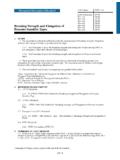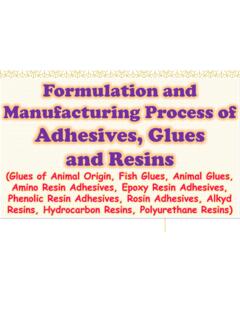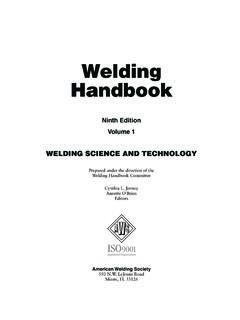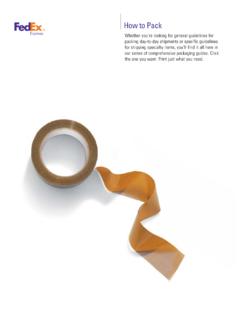Transcription of Standard Test Methods for Measuring Adhesion by Tape Test1
1 Designation: D3359 09 2 Standard Test Methods forMeasuring Adhesion by Tape Test1 This Standard is issued under the fixed designation D3359; the number immediately following the designation indicates the year oforiginal adoption or, in the case of revision, the year of last revision. A number in parentheses indicates the year of last reapproval. Asuperscript epsilon ( ) indicates an editorial change since the last revision or reapproval. 1 NOTE Footnote 5 and were corrected editorially in June 2010. 2 NOTE Footnote 5 and were corrected editorially and moved into Note 4 in in July Scope* These test Methods cover procedures for assessing theadhesion of coating films to metallic substrates by applying andremoving pressure - sensitive tape over cuts made in the This test method has been reported being used to measureadhesion of organic coatings on soft substrates (for example, wood andplastic).
2 Issues with plastic substrates are noted inAppendix X1. A similartest method, ISO 2409, permits tests on soft substrates (for example, woodand plaster). Precision and bias data on the later is lacking. Test MethodsD3359 was developed with metal as the substrate and, in the absence ofsupporting precision and bias data, is so Test Method A is primarily intended for use at job siteswhile Test Method B is more suitable for use in the , Test Method B is not considered suitable for films thickerthan 5 mils (125 m).NOTE2 Subject to agreement between the purchaser and the seller,Test Method B can be used for thicker films if wider spaced cuts These test Methods are used to establish whether theadhesion of a coating to a substrate is at a generally adequatelevel.
3 They do not distinguish between higher levels ofadhesion for which more sophisticated Methods of measure-ment are It should be recognized that differences in adherability of thecoating surface can affect the results obtained with coatings having thesame inherent This test method is similar in content (but not techni-cally equivalent) to ISO In multicoat systems Adhesion failure may occur be-tween coats so that the Adhesion of the coating system to thesubstrate is not The values stated in SI units are to be regarded as thestandard.
4 The values given in parentheses are for Standard does not purport to address the safetyconcerns, if any, associated with its use. It is the responsibilityof the user of this Standard to establish appropriate safety andhealth practices and determine the applicability of regulatorylimitations prior to Referenced Standards:2D609 Practice for Preparation of Cold-Rolled Steel Panelsfor Testing Paint, Varnish, Conversion Coatings, andRelated Coating ProductsD823 Practices for Producing Films of Uniform Thicknessof Paint, Varnish, and Related Products on Test PanelsD1000 Test Methods for pressure - sensitive Adhesive-Coated Tapes Used for Electrical and Electronic Applica-tionsD1730 Practices for Preparation of Aluminum andAluminum-Alloy Surfaces for PaintingD2092 Guide for Preparation of Zinc-Coated (Galvanized)
5 Steel Surfaces for Painting(Withdrawn 2008)3D2370 Test Method for Tensile Properties of Organic Coat-ingsD3330/D3330 MTest Method for Peel Adhesion of pressure - sensitive TapeD3924 Specification for Environment for Conditioning andTesting Paint, Varnish, Lacquer, and Related MaterialsD4060 Test Method for Abrasion Resistance of OrganicCoatings by the Taber Abraser1 These test Methods are under the jurisdiction of ASTM CommitteeD01onPaint and Related Coatings, Materials, and Applications and are the directresponsibility of Physical Properties of Applied edition approved June 1, 2009.
6 Published June 2009. Originallyapproved in 1974. Last previous edition approved in 2008 as D3359 08. referenced ASTM standards, visit the ASTM website, , orcontact ASTM Customer Service at ForAnnual Book of ASTMS tandardsvolume information, refer to the Standard s Document Summary page onthe ASTM last approved version of this historical Standard is referenced *A Summary of Changes section appears at the end of this standardCopyright ASTM International, 100 Barr Harbor Drive, PO Box C700, West Conshohocken, PA 19428-2959.
7 United States1 Copyright by ASTM Int'l (all rights reserved); Sat Jun 21 14:38:11 EDT 2014 Downloaded/printed byMichael Zimmerman (Tank Paint) pursuant to License Agreement. No further reproductions Standard :ISO 2409 Paint and Varnishes Cross-cut test43. Summary of Test Method A An X-cut is made through the film tothe substrate, pressure - sensitive tape is applied over the cut andthen removed, and Adhesion is assessed qualitatively on the 0to 5 Method B A lattice pattern with either six oreleven cuts in each direction is made in the film to thesubstrate, pressure - sensitive tape is applied over the lattice andthen removed.
8 And Adhesion is evaluated by comparison withdescriptions and Significance and If a coating is to fulfill its function of protecting ordecorating a substrate, it must adhere to it for the expectedservice life. Because the substrate and its surface preparation(or lack of it) have a drastic effect on the Adhesion of coatings,a method to evaluate Adhesion of a coating to differentsubstrates or surface treatments, or of different coatings to thesame substrate and treatment, is of considerable usefulness inthe The limitations of all Adhesion Methods and the specificlimitation of this test method to lower levels of Adhesion ( ) should be recognized before using it.
9 The intra- andinter-laboratory precision of this test method is similar to otherwidely-accepted tests for coated substrates (for example, TestMethodD2370and Test MethodD4060), but this is partly theresult of it being insensitive to all but large differences inadhesion. The limited scale of 0 to 5 was selected deliberatelyto avoid a false impression of being METHOD A X-CUT TAPE TEST5. Apparatus and Tool Sharp razor blade, scalpel, knife or othercutting devices. It is of particular importance that the cuttingedges be in good Guide Steel or other hard metal straightedge toensure straight 25-mm ( ) wide semitransparent pressure - sensitive tape with an Adhesion strength agreed upon by thesupplier and the user is needed.
10 Because of the variability inadhesion strength from batch-to-batch and with time, it isessential that tape from the same batch be used when tests areto be run in different laboratories. If this is not possible the testmethod should be used only for ranking a series of Permacel P99 tape, previously identified as suitable for thispurpose, was withdrawn from manufacture in July 2009. Current suppliesof Permacel 99 on the market at this time have a shelf life that runs out inJuly 2010. Subcommittee is assessing alternative tapes and a newinterlaboratory study is planned to take place in 2010.











